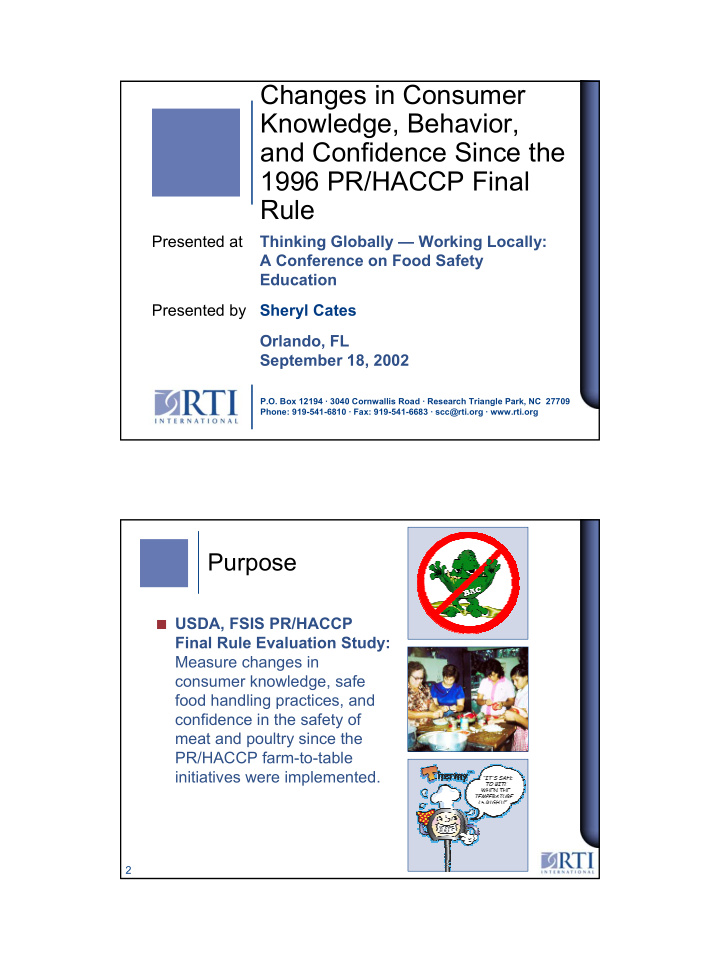



Changes in Consumer Knowledge, Behavior, and Confidence Since the 1996 PR/HACCP Final Rule Presented at Thinking Globally — Working Locally: A Conference on Food Safety Education Presented by Sheryl Cates Orlando, FL September 18, 2002 P.O. Box 12194 · 3040 Cornwallis Road · Research Triangle Park, NC 27709 Phone: 919-541-6810 · Fax: 919-541-6683 · scc@rti.org · www.rti.org Purpose � USDA, FSIS PR/HACCP Final Rule Evaluation Study: Measure changes in consumer knowledge, safe food handling practices, and confidence in the safety of meat and poultry since the PR/HACCP farm-to-table initiatives were implemented. 2 1
Existing Data Sources Year(s) of Data Sponsor Study Collection ADA & ConAgra Home Food Safety 2001 Refrigeration Survey Audits International Home Food Safety Study 1997, 1999, 2000 CDC, FoodNet Population Survey 1996/97, 1998/99, 2000/01 FDA & FSIS Food Safety Survey 1993, 1998, 2001 FDA Utah State University Study 1999 Penn State University Food Safety Survey 1998, 1999, 2001 3 FSIS-Sponsored Consumer Focus Groups Study Population Year Food Safety Messages and Delivery Mechanisms General & 2000 High Risk http://www.fsis.usda.gov/OA/research/fsmessages.pdf Listeriosis Food Safety Messages and Delivery Pregnant 2001 Mechanisms Women http://www.fsis.usda.gov/OA/research/lmfocus.pdf Thermometer Usage Messages and Delivery Parents of 2002 Mechanisms Young Children http://www.fsis.usda.gov/OA/research/rti_thermy.pdf Changes in Consumer Knowledge, Behavior, and General & 2002 Confidence High Risk 4 2
Reported vs. Actual Behavior � In surveys and focus groups, consumers report that they are more knowledgeable about food safety and have improved certain safe handling practices � However, observation studies show that actual practices often differ from reported practices Utah State University Study (1999) Wash hands all or Reported Actual most of the time before food preparation 87% 45% 5 Reported Safe Handling Practices: Clean and Separate (FDA/FSIS Food Safety Survey) 100% Percentage of Consumers (%) 85% 82% 79% 76% 80% 72% 68% 68% 66% 60% 40% 20% NA 0% Always wash hands Usually wash hands Properly clean cutting 1993 with soap before with soap after handling boards or other 1998 preparing food raw meat/poultry surfaces to prevent 2001 cross-contamination 6 3
Reported Safe Handling Practices: Cook (FDA/FSIS Food Safety Survey) 100% Percentage of Consumers (%) 80% 60% 60% 46% 40% 32% 22% 20% 12% 6% 6% 3% 0% Own a food Always/often use Always/often use Always/often use 1998 thermometer thermometer- thermometer- thermometer- 2001 roasts* chicken parts* hamburgers* *Includes non-thermometer owners. 7 Safe Handling Practices: Chill (FDA/FSIS Food Safety Survey & ADA/ConAgra Home Refrigeration Survey) 100% Percentage of Consumers (%) 80% 60% 46% 40% 40% 33% 26% 20% NA NA NA NA 0% Safely store Safely defrost Own a Aware of proper 1993 large amounts meat/poultry refrigerator refrigerator 2001 of leftovers (<2 thermometer temperature hrs + shallow containers) 8 4
Knowledge of “High-Risk” Foods, High-Risk Populations, and Pathogens � Perception of meat and poultry as “high-risk” foods has increased � Limited knowledge of high-risk populations � Awareness of pathogens has increased; however, consumers do not always follow practices to minimize pathogens 9 Awareness of Foodborne Pathogens (FDA/FSIS Food Safety Survey) 100% 93% 93% 88% Have you ever heard of 85% [pathogen] as a Percentage of Consumers (%) 79% 80% problem in food? 60% 40% 31% 20% 14% 9% 5% 7% 8% NA 0% Salmonella E. coli Listeria Campylobacter 1993 1998 2001 10 5
Focus Group Findings on Changes in Consumer Knowledge and Behavior � Reported changes � Switch from wood to plastic cutting boards � Defrost foods in refrigerator � More conscientious about hand washing � Overcook meat and poultry � Use food thermometer � Participants attribute behavioral changes to media coverage of food safety � Many participants rely on food labels for food safety information 11 Audits International Home Food Safety Study 50% Percentage of Households (%) 40% 30% 25% 25% 20% 10% 4% 0% 1997 1999 2000 Acceptable Performance Acceptable Performance = no critical violations and no more than four major violations 12 6
Focus Group Findings on Changes in Consumer Confidence � Participants’ confidence in the safety of meat and poultry has increased or remained about the same � Participants attribute their increased confidence to media coverage of food safety � Participants think the government is doing an adequate job keeping meat and poultry safe � Most participants think the government has not improved its performance in the past 5 years 13 Consumer Confidence in the Safety of Meat and Poultry � Most consumers willingly accept responsibility for ensuring that the food they eat is safe � Most consumers are confident that the meat and poultry they prepare at home is safe to eat � Consumers worry more about how meat and poultry are handled prior to purchase than about how they handle it at home � Believe foodborne illness originates in food processing plants and restaurants, not their homes � Concerns about antibiotic residues � Concerns about food transportation 14 7
Conclusions (I) � Consumers’ reported knowledge and use of safe handling practices have increased; however, when observed consumers do not always follow safe practices � Although the self-reported use of some practices has increased, additional improvements are warranted � Food thermometer use � Safely storing leftovers � Safely thawing meat/poultry 15 Conclusions (II) � Consumers have some knowledge about foodborne pathogens, “high-risk” foods, and high-risk populations, but their knowledge is sometimes wrong or incomplete � Consumer confidence in the safety of meat and poultry has increased or remained about the same � Consumers are satisfied with the government’s performance at ensuring the safety of meat and poultry 16 8
Thinking Globally -- Working Locally A Conference on Food Safety Education 17 9
Recommend
More recommend